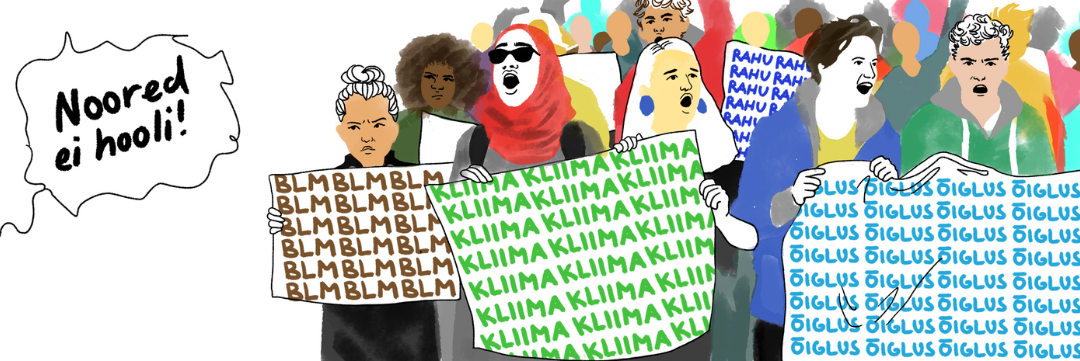
Alexandre Fonseca, Youth Participation Coordinator at SALTO Participation & Information
Participation is part of the central policies and treaties of the United Nations and the European Union. Article 12 of the UN Convention on the Rights of the Child and Article 165.2 of the Treaty of the European Union specifically address the right of young people to be heard on matters affecting their lives.
The EU Youth Strategy encourages EU member states to promote the inclusive democratic participation of all young people in society and its democratic processes. The Strategy annex also includes the Youth Goals, created by 50,000 young people through the EU Youth Dialogue, with Youth Goal#9 focusing on Space and Participation for All. In 2020, the Youth Participation Strategy was launched to enhance youth participation in democratic life through the Erasmus+ and European Solidarity Corps programmes.
Despite the numerous treaties and strategies, do young people really “not care”? Furthermore, if they do not, can something be changed? To answer these questions, we talked with young people and youth workers active in Portugal. We first examine the validity of this claim and then analyse two different visions of participation (as a right and as a competence). Finally, we consider the outlook of participation together with the youth workers and young people interviewed.
Young People Do Not Care! Or Do They?
In the aftermath of the Presidential Election in Portugal, which had over 60% abstention, the Portuguese Youth National Council released a study that showed that young people did not have lower turnout in the polls than other age groups. Luís, from the Pool of Facilitators of the Youth Municipal Plan of Guimarães, a Portuguese municipality in the north of the country, wonders:
“Were young people the cause of abstention or is it a problem of the whole society? For which youth is scapegoated?”
Still, the argument that a particular generation is lost or does not care seems to be expressed by every other generation. “Young people not caring is an old idea”, argues Luís, “one which is difficult to change and originates from the association between youth and a bohemian life”. For Rita Miranda, herself a member of the same Pool of Facilitators, “there are indeed high numbers of young people who aren’t interested in participation, but so aren’t many people in adulthood (and beyond)”.
According to the Youth Participation Strategy, the interest of young people in politics and participation is not decreasing but rather changing. Young people are actively engaged, but not in the traditional forms of participation, such as voting or being represented in assemblies, parties, or labour unions. In the Strategy, these forms are identified as alternative forms of participation, including activism and youth movements, mostly identified with a single cause (e.g. environment, discrimination, among others), digital participation and use of social media and diverse forms of co-creation and co-design of youth policies, such as youth participatory budgets or municipal youth plans1. José Dias, a youth worker and project manager from Braga, echoes this view:
“Young people are still participating and interested. The ways and mechanisms of participation have changed compared to those we were used to. Young people have left the ‘traditional spaces of participation’. If we want to reach them, it has to be through social media”.
Why does the idea that young people do not care then persist? Might it be a way for some institutions to hide their lack of accessibility? As José explains:
“Young people do not talk with institutions, they talk with people, to their peers, this is why they don’t identify or relate to institutions. Because of this, young people move away from formal institutions. And just as society and institutions do not identify with young people, they do the same.”
Is there a way to bridge this gap? Can a rights-based approach to participation be helpful in addressing this problem and supporting both institutions and young people?
Participation as a Right
Participation is a Human Right. As such, it is a given that young people possess it as citizens. Adopting a rights-based approach is a way of addressing the power differential between adults and children. If the child is a rights holder, by definition, taking their views into account becomes their entitlement, not a gift of the adult or an institution2.
With Human Rights as the framework to promote well-being, of which participation is a sine qua non condition, participation becomes the right to be heard and express one’s views on matters that affect young people. With this approach, listening to young people’s views and acting upon them should become usual practice, whereby young people receive equal treatment and the opportunity to be heard and to have an impact. As young people are exposed to specific vulnerabilities in their capacity to influence their communities, this approach also protects them.
While hearing their voices is crucial, it is important to understand that young people already have a voice. What they need are the conditions, structures, and support for their voices to be effective. In her seminal article Voice is Not Enough: Conceptualising Article 12 of the United Nations Convention on the Rights of the Child, Laura Lundy proposes the model and conditions for young people’s voice to be influential.
For Lundy, young people need to be provided with the space, audience and influence, meaning that the views expressed must be listened to and acted upon, as appropriate. If institutions and their staff can be improved to support and acknowledge the influence of young people, can the same be said for young people’s ability to participate?
Participation as Competence
Considering participation as a competence means searching for ways, spaces, and approaches that allow young people to be more active and confident in their participation. With participation in formal settings declining, there has been an increasing preoccupation with improving these skills in young people. The EU Youth Goal #7, Quality Learning, echoes that worry, with one of its targets addressing citizenship education and community-based experiences promoting participation.
While there are different approaches to teaching these skills, as Anne Crowley and Dan Moxon argue in the study New and Innovative Forms of Youth Participation in Decision-making Processes, “what seems to be clear is that education is the key to participation”. For the authors, the best approach to teach young people to participate is to provide the conditions for the participants to do it themselves. Maria Carvalho, a youth worker and a graduate in Education, agrees:
“As youth workers, we have to create and provide spaces where all can take part, whether this participation is the most correct or the kind we expected or not. School must be the starter for participation, so that young people feel more capable of doing so. More active students also mean more engaged citizens in society”.
Beyond school, there are also many opportunities provided by non-formal education3. For Rita, supporting the construction of the Youth Municipal Plan of her city was a great learning experience. According to her, participation rewards those who seek it, as it is a tool of knowledge, involvement and personal, professional and civic development. José agrees: “When we participate, we develop different skills”. However, rather than being empowered, according to him, participants are involved and engaged4 – a subtle but crucial difference when approaching youth participation as a competence.
Nevertheless, all the initiatives mentioned that the aim of enhancing and fostering the participation of young people must be accompanied by a democratic environment that appreciates and supports this participation. Without it, initiatives improving the competences of young people to participate will be nothing more than tears in the rain.
Youth Participation in 2021: Tears in the Rain?
What is the state of youth participation in 2021? The article Engagement of young people, deconfined? flashes back to the beginning of 2020: “2020 seemed to announce a new year of strong citizen mobilisations. Hong Kong students defending their civil and political rights, US activists claiming ‘black lives matter’, Chileans choreographing the fight against patriarchal violence, young people marching for the climate”. And after that… silence.
The pandemic and, most of all, some of the measures taken to combat it, froze or forced the adaptation of participatory initiatives and youth movements worldwide. Society is sensitive, intolerant, and polarised, believes José Dias. Therefore, youth workers need to be even more attentive and develop ways to approach sensitive topics wisely and carefully. For Maria Carvalho, those working closely with young people need to stop and think about how the young person feels and their internal struggles, dreams, and fears.
Despite the grimmer scenario, both Luís and Rita are optimistic about their participation, believing that more opportunities to develop their competences and become even more engaged will come. Challenges are extensive and possibly increasing. As youth workers and educators, maybe we will never do away with the idea that young people do not care. All we can do is focus on those we can influence and support to be more active. To conclude, if it is any consolation, it is worth reminding ourselves that in countries where age-related inequalities are smaller, overall life satisfaction is higher. And there is nothing better to achieve than satisfaction with one`s life.
- The section “Alternative Forms of Participation” in the Participation Resource Pool offers many resources to deepen this understanding. ↩︎
- This point is inspired by Laura Lundy, Lesley McEvoy & Bronagh Byrne (2011) Working With Young Children as Co-Researchers: An Approach Informed by the United Nations Convention on the Rights of the Child, Early Education and Development, 22:5, 714-736. ↩︎
- Some of these spaces can be created, when drafting a municipal plan, being consulted on a topic, debating with peers or proposing and defending a project for a participatory budget, or sometimes just presenting the situation. If these conditions are not provided, not only may people leave dissatisfied with the experience, but they may also be discouraged about future approaches to participation. The Erasmus+ and European Solidarity Corps are also excellent laboratories for young people to experiment and try out for themselves what participation entails. The Youth Participation Toolkit might support you, as a youth worker or as a young person, to develop participation in your activities. ↩︎
- The mindset of empowering someone might be similar to the adult giving an opportunity to the young people to be heard, instead of hearing young people because it is their right. The distinction here is crucial because if one has the empowerment mindset, they might see themselves on a different plane than the young person – I am giving the competences to participate. Instead, if the adult sees the young person involved and engaged, it means that both are developing and increasing their competences, albeit in different aspects, to participate. With this different mindset, participation, once again, in the words of Laura Lundy, does not become the gift of the adult, but the entitlement of the young person. ↩︎
The cover image was designed by young Estonian artist Margaret Pütsepp.

